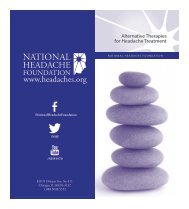2_SAGE_Appendicies_Background_final
2_SAGE_Appendicies_Background_final
2_SAGE_Appendicies_Background_final
You also want an ePaper? Increase the reach of your titles
YUMPU automatically turns print PDFs into web optimized ePapers that Google loves.
was more hesitant than the younger generation and another, that women were more hesitantthan men.Six of 13 immunization managers mentioned the role of influential leaders in increasingvaccine hesitancy among the population. These leaders were associated with anti-vaccinationgroups, religious groups or health professional groups.Five of 13 immunization managers identified causes of vaccine hesitancy linked to the“communication and media environment”. Two immunization managers spoke broadly about“rumors and misconceptions” regarding vaccination circulating in their country and threedirectly identified negative information conveyed in the mass media (television and internet)as causes of vaccine hesitancy.Six immunization managers identified the involvement of geographic barriers in reducingaccess to vaccination services, but the association with vaccine hesitancy was not clear.In one country, political conflicts and instability leading to poverty, internal populationdisplacements and insecurity, could partially explain vaccine hesitancy. More than onequarter of the population has no access to health services, as noted above. Access to serviceswas stated to be particularly difficult for women.Finally, in one country, vaccine hesitancy was mostly clustered around illegal settlers orimmigrants without an official status. These individuals hesitate to use health servicesbecause of fear of being reported to the police, even though the Expanded Programme onImmunization (EPI) offers immunization with permission from the government.3.3.2. Individual and group influencesThree main determinants of vaccine hesitancy pertaining to individual and group influenceswere identified. First, seven of 13 immunization managers identified risk perceptions asassociated with vaccine hesitancy. This included concerns regarding vaccine safety, lack ofperceived benefits of vaccination and lack of understanding the burden of vaccinepreventablediseases.Second, seven immunization managers identified issues to the population’s trust in the healthsystem and health providers. One noted that how people were treated in the health servicescould have a negative impact on whether they returned while others highlighted theinfluential role that health care workers have on vaccine acceptance among the population. Inone country, women prefer to receive care by female providers, which are scarce in thatcountry and could at least partially explain the lack of vaccination among women.Finally, four immunization managers identified that lack of knowledge (or misinformation) inthe population regarding vaccination was a contributing factor to vaccine hesitancy. Oneimmunization managers specified that lack of knowledge about vaccination among healthprofessionals was linked to vaccine hesitancy.14



